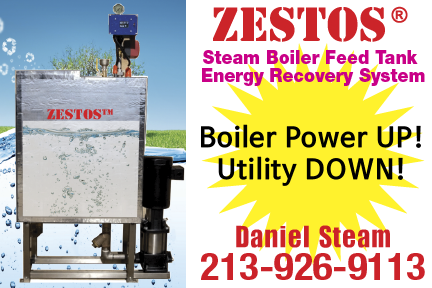In last month’s issue, space limitations prevented me from concluding the article on solvent heating, so I’ll be concluding that topic in this issue.
 1a. STEAM TRAP
1a. STEAM TRAP
Similar to any other steam-heated device, there is a steam trap is installed at the outlet of the steam jacket on the bottom of the still. Common problems with steam traps:
- TRAP STUCK SHUT
If the trap is partially stuck shut, the still will not heat properly. This will stop or greatly slow the rate of distillation, even preventing any distillation from taking place at all. - TRAP STUCK OPEN
This condition is harder to diagnose since in most cases there will be no change in distillation performance. However, in situations where the boiler power is limited, the extra steam load caused by a trap stuck open may drop the steam pressure, reducing or greatly slowing the rate of distillation.
4. STEAM SWEEP VALVE
Found on perc machines, this valve is used to admit live steam into the still at the end of the distillation cycle. The steam mixes with the solvent still in the still bottom and forms what’s known as an azeotropic mixture. This mixture boils at a lower temperature than perc, thereby boiling off (evaporating) most of the solvent remaining in the still bottom.
Common problems associated with this valve are:
- VALVE OPEN TOO MUCH or LEFT OPEN
Normally there is a restrictor in series with this valve which limits the flow of steam into the still. However, on some machines this is absent, and the flow of steam needs to be controlled by adjusting the valve opening manually. If the valve admits too much steam into the still it may overly pressurize the condensing system resulting in extreme surging. This forces contaminated and/or unseparated water (more to follow about water separation in this series) into the distilled solvent storage tank. Also, if excess steam enters the still, it is possible to overwhelm the water separation process and overheat the solvent/water mixture. The result of this is inefficient solvent/water separation. - VALVE LEAKING
If the steam sweep valve leaks the result is usually an overheated still condenser, a tendency for the still to boil over, excess water discharging from the water separators water discharge valve. The presence of water droplets on the still sight glass, throughout the distillation cycle, even after several minutes of the addition of new solvent to the still is a very accurate indicator of this condition.
5. STILL PRESSURE RELIEF VALVE
This valve is designed to open if a preset pressure is exceeded. In this application it prevents exceeding the proper pressure required to assist in forcing solvent vapors up and into the still condenser. When the distillation system is operating properly you will not even know this valve is there.
Common problems associated with this valve are:
- VALVE STUCK OPEN
You will know if this valve is stuck open as soon as the still heats up enough to vaporize solvent. Large quantities of solvent vapor will exit from the still area and you’ll be able to smell solvent odor as well as see solvent vapor condensing around the outside of the still. - VALVE STUCK SHUT
If this valve sticks shut and the still is operating correctly there will be no indication at all. Should the still overheat or a blockage develops at the inlet or outlet of the still riser, there will be a very strong solvent odor and likely vapor or liquid solvent leaks at flanges and/or unions in the vapor path from the still as well as around any access to the still like clean-out door and/or sight glass gaskets.
6. BOIL OVER SENSOR
This device is found mostly on the stills of newer machines that distill under a vacuum. It detects the height of the foam and/or solvent level inside the still shutting off the steam supply and/or opening a solenoid valve connecting inside of the still to the atmosphere. On machines using vacuum and heat to evaporate the solvent, this will instantly lower the pressure inside the still, interrupting the distillation process and reducing the foaming on top of the solvent. Usually, there is some error indication when this sensor is activated.
Common problems associated with this sensor are:
- SENSOR CONTINUOUSLY ACTIVATED
If this condition is present, you will be unable to pull a vacuum in the still. The vacuum pump will operate continuously without the distillation process starting. An error condition will usually be indicated. - SENSOR FAILS TO ACTIVATE
If the still is working properly there will be no indication of this device failing. However, if there is a still condition resulting in excessive foaming, there will likely be still boilovers with the resultant contamination of the water separator(s) and distilled solvent storage tank.
7. HIGH-LEVEL SAFETY SWITCH
This is a float-operated switch monitoring the level of solvent in the still. Inside the still is a ball float which is linked to an electric switch on the outside of the still. If the level of solvent in the still exceeds a preset safety point this device typically shuts off the solvent pump preventing any further filling of the still as well as shutting off the still steam control valve preventing any further heating of the still. There is typically some form of error indication when this switch is activated.
-
- SWITCH FAILS ACTIVATED- If this switch fails activated the most obvious symptom will be the solvent pump will not operate as well as an error message. In addition, the still steam control valve will not open unless there is an override this presents the problem of how to boil off the excess solvent in the still. I’ll cover that procedure in another article.
That’s it for this issue, next issue will be about the system that condenses the hot solvent into pure distilled solvent to be reused over and over again.

Bruce Grossman
Bruce Grossman is the Chief of R&D for EZtimers Manufacturing. EZtimers is the manufacturer of the new EZ DOSE boiler compound manager and return tank level control which replaces that troublesome ball float valve in the condensate return tank and automatically adds the correct amount of boiler compound to the return tank preventing the oxygen corrosion and scaling. Our SAHARA and DIB-M high purity separator water mister/evaporators provide a thrifty, legal method to get rid of the separator water generated by your dry-cleaning machine. See our Ad in this issue and for further information on EZtimers products visit www.eztimers.com Please address any questions or comments for Bruce to bruce@eztimers.com or call 702-376-6693.


